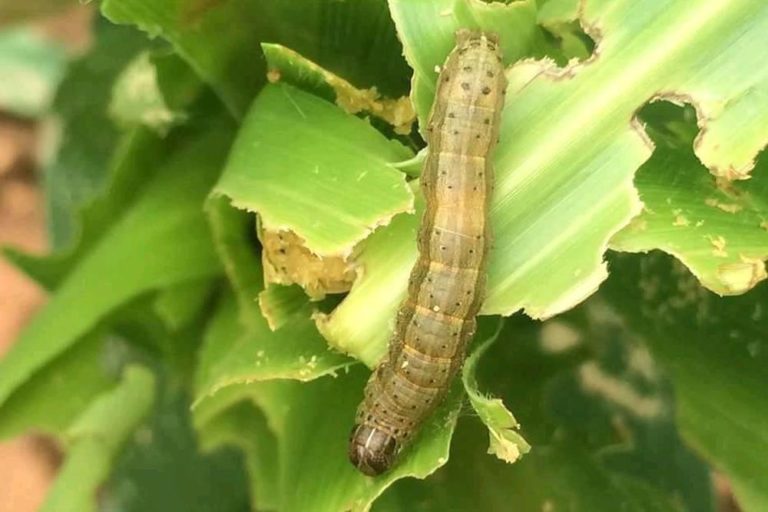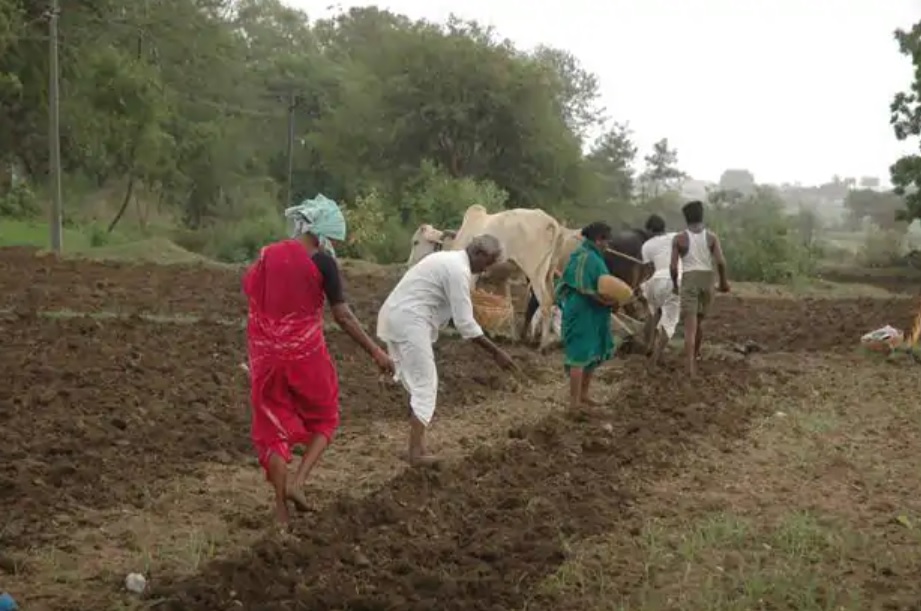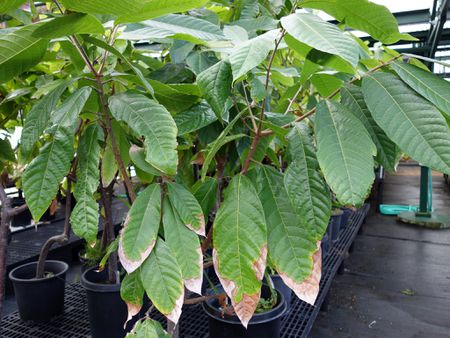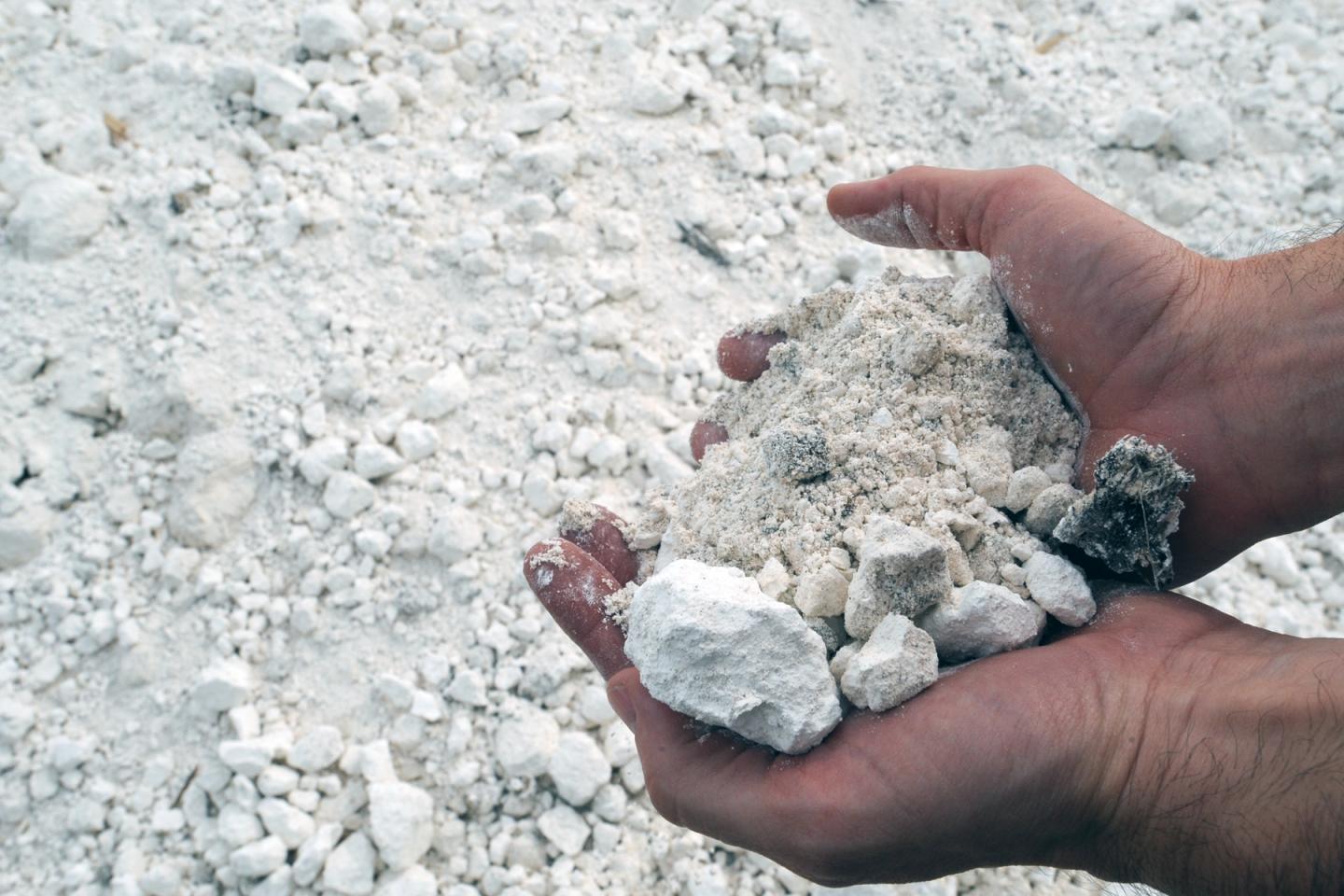- This insect hides in piles of soil, straw, weeds during the day, and eats crops overnight. Huge numbers of these insects can be seen in infested farms/crops. This pest tends to damage the entire crop by feeding in a very short time. Hence management/control of this pest is very necessary.
- In areas where the infestation of fall armyworm pests is high, spraying any of the following insecticides should be done immediately.
- Spray: – LAMBDA CYHALOTHRIN 4.6% + CHLORANTRANILIPROLE 9.3% ZC 100 ml / acre, or CHLORANTRANILIPROLE18.5% SC @ 60 ml / acre, or EMAMECTIN BENZOATE 5% SG @ 100 gram / acre
- Biological treatment BEAUVERIA BASSIANA @ 250 gram/acre
- In areas where its attack is less, Farmers should place small piles of straw on the border of their farmland or in the middle of the field if possible. During the day the armyworm hides in these straw piles in search of shade. In the evening this straw should be collected and burnt.
Weed management in Soybean crop in 20 to 50 days
- Soybean is the main Kharif crop and due to continuous rain it is very important to follow timely weed control after sowing of the crop.
- After sowing of the Soybean crop, there is an increase in growth of weeds like broad leaf and narrow leaf.
- In between day 20 to 50 of the soybean crop, narrow leaf weeds are more harmful, so it is very important to control them. The following products can be used to control these weeds.
- Propaquizafop 10% EC @ 400 ml/acre This is a selective herbicide and used to control narrow leaf weeds.
- Quizalofop Ethyl 5% EC @ 400 ml/acre is a selective herbicide and used to control narrow leaf weeds.
Farmers of Madhya Pradesh have sown kharif crops in 118 lakh hectare till now
After being at the forefront of the procurement of wheat, now farmers of Madhya Pradesh are now meeting the target set for sowing in the Kharif season as well. The farmers of the state have so far sown Kharif crops in 118 lakh hectares of land. This figure is 80% of the total target set. Soon, the farmers will not only achieve their target up to 100% but will also go ahead of the target. Significantly, this year, a target of sowing 146.31 lakh hectare for the Kharif season.
Sowing of soybean, the main Kharif crop in the state, has been completed up to 97%. The target for the sowing of soybean has been fixed at 57.70 lakh hectare and to date, 56.42 lakh hectare has been sown. Apart from this, the target of crops like groundnut, sesame, cotton has also been almost achieved.
Source: Nai Dunia
ShareFertilizer management in cotton crop at the time ball formation
- In 50-70 days ball formation starts in the cotton crop.
- Nutrition management is very important for good ball formation.
- For this, using urea – 30 kg / acre, MoP (potash) 30 kg / acre, magnesium sulfate – 10 kg / acre is very important.
- Timely nutrition management helps in good ball formation growth and farmers get the produce of high quality from the crop.
Plant growth regulator and its importance
- Plant growth regulators act as growth regulators for crops.
- It plays a very important role in the growth of roots, growth of flowers.
- Crops require oxygen and micronutrients for growth, all of these provided by the plant growth regulators.
- Crops require very small amounts of these
- They act on those parts of crops which play an important role in root development, fruit development, flower production, etc.
- The crops that remain small are helpful in the growth by increasing the length of the stems of those crops.
- Help to break the dormancy in seeds by cell division.
NABARD to provide Rs. 5000 crore loan to farmers for Kharif farming
Different financial institutions keep coming up to provide loans to farmers. In this series, loans will be provided to the farmers of the entire country for the cultivation of Kharif crops by the National Bank for Agriculture and Rural Development. NABARD has sanctioned a large fund of Rs 5000 crores for this loan.
This loan of 5000 thousand crore rupees will be provided to farmers across the country through Cooperative Bank, Grameen Bank, Micro Financing Institution, and NBFC. Significantly, NABARD has recently celebrated its 59th anniversary. Chief General Manager of the institute Subrata Mandal said these things at a function organized on this occasion.
Subrata Mandal said that “the lockdown has been prohibited on a collection of installments from borrowers for six months. This will provide relief to the farmers. In order to ensure that the farmers do not have cash for farming in the Kharif season, NABARD has 5000 thousand crores has been sanctioned. This amount will be disbursed through various financial institutions in the form of loans to farmers across the country.
Source: Krishi Jagran
ShareCauses of burning and scorching of crop leaves
- There can be many reasons for burning crop leaves.
- Pest disease and nutritional deficiency are also the cause of burning of leaves.
- Any type of pest and insect in the roots like nematode, cutworm, etc., cuts off the roots of the crops, due to which the leaves start falling and scorching.
- One of the most common causes of leaf burns and scorching is the disease of roots, due to the infection of fungus in the roots, the roots get damaged and the leaves start burning and scorching.
- Another common cause of scorching is the deficiency of nutrients in the soil and due to which the edges of the leaves start drying up.
- Some pollutants are found in the air which stick on the surface of the leaves and can burn the edges of the leaf.
Importance of gypsum in soil
- Gypsum helps in stabilizing the pH value of the soil and improves the alkaline soil.
- Essential for good growth of crops and roots
- Using gypsum ensures the availability of nitrogen, phosphorus, potassium, calcium, and sulfur in the soil.
- It’s a good source of calcium and sulfur.
- Gypsum is used to increase crop production
- Gypsum is used before sowing.
- Make sure to do light plowing in the field after using gypsum
- The amount of gypsum to be used depends on the nature of the soil.
- There should not be much moisture in the field at the time of the use of gypsum.
- The hands should be completely dry at the time of broadcasting
Heavy rains may occur in these states, know weather forecast for next 24 hours
Monsoon has become active in most of the states of the country and its effect is also visible. Mumbai and Gujarat have received heavy rainfall for the last few hours. Along with this, many areas of Kerala are also receiving continuous rains. In Assam, a flood situation has been created due to rain.
The axis of Monsoon trough currently extends to the northern parts of the Bay of Bengal via Faludi, Ajmer, Umaria, Ambikapur, Jamshedpur and Digha. A cyclonic circulation is also seen over interior parts of Madhya Pradesh.
According to the Meteorological Department, moderate to heavy rain in coastal Karnataka, Kerala and sub-Himalayan West Bengal over the next 24 hours. Light to moderate rain in some areas of Konkan Goa, Uttarakhand, Terai regions of Uttar Pradesh, Assam, Meghalaya, Arunachal Pradesh and North Coastal Andhra Pradesh. Jammu and Kashmir, Himachal Pradesh, Gilgit-Baltistan, Muzaffarabad, Uttar Pradesh, North Bihar, Gangetic West Bengal, Odisha, South and South-Western Madhya Pradesh, Gujarat, South-Eastern Rajasthan, Telangana, Punjab, Haryana and parts of Delhi light to moderate rains may occur.
Source: Krishi Jagran
ShareBoron’s importance for crops
- Boron helps in the synthesis of carbohydrates in plants.
- Helped in formation in root nodules leguminous crops
- improve pollination in flowers.
- Plays an important role in protein synthesis
- Plants remain dwarf and crops grow very slowly due to boron deficiency .
- Internodes are small.
- The growth of roots stops and roots and stems remain hollow.










